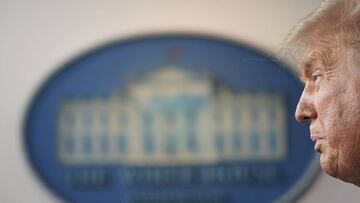$400 unemployment benefits boost: why could it be delayed?
As part of a series of executive orders issued on Saturday, US President Donald Trump is seeking to give Americans an extra $400 a week in unemployment insurance.

White House Press Secretary Kayleigh McEnany on Monday expressed her optimism that Americans will start to receive the extra unemployment insurance included in US President Donald Trump’s recent executive orders “close to immediately”. Meanwhile, Larry Kudlow, an economic adviser in the Trump administration, said on Tuesday that the benefits boost should arrive in two weeks.
However, experts consulted by the US media appear less confident about how long it will take to materialize - if indeed it materializes at all.
See also:
- Second stimulus check: Senate leaves without coronavirus relief deal
- 400 extra unemployment benefits: when does it start?
- Trump executive order: how much will it cost the US?
- Second stimulus check: could eligibility change?
- $400 unemployment benefits boost: why could it be delayed?
Trump executive order seeks $400 benefits boost
Among a series of executive orders issued on Saturday, Trump vowed to give out-of-work Americans an extra $400 a week in unemployment benefits, replacing the $600 supplement they had received until the end of July as part of the CARES Act.
Under the president’s plan, the federal government would contribute $300 a week, while states were asked to pay $100. The boost would only be available to claimants who qualify for over $100 a week in regular unemployment pay.
Trump’s executive orders, which also included an evictions moratorium, the suspension of student loan payments and interest, and a deferral of payroll tax, came after White House chiefs and Democrat leaders failed to agree a new package of coronavirus relief measures by their self-imposed deadline of Friday last week.
New payment systems needed for benefits boost
One problem with Trump’s proposed enhanced benefits is that states are likely to need some time to get their payment systems ready for the scheme. Speaking to Yahoo! Money, Michele Evermore of the National Employment Law Project said: “It will take at least a month, and that's being very optimistic about a lot of things.”
Part of the issue, Evermore explained in a separate interview with CNBC, is that states have to route the federal money from a new source - the Department of Homeland Security's Disaster Relief Fund (DRF) - that is unrelated to those they typically draw benefits from. “This is actually not something states have ever had to do before,” she said.
$45bn available in DRF could be spent within five weeks
Trump’s scheme would last through to 6 December or until the DRF dropped to $25bn - whichever happened earlier (the fund currently has a balance of about $70bn). According to the Committee for a Responsible Federal Budget, however, the $45bn available in the DRF would be unlikely to last until December - and could be spent within just five weeks.
States will also have to negotiate an application process before being given access to the $300 in federal funds, and “may ultimately decide it’s not worth the cost and effort to administer for only a few weeks’ worth of money,” writes Greg Iacurci in CNBC, citing the opinion of University of Illinois economist Eliza Forsythe.
States say they can't afford $100 contribution
Governors have questioned the feasibility of Trump’s executive order, not only because of the practical difficulties they appear to face in implementing it, but also from the point of view of how they are expected to afford it, given that states are currently nursing a combined budget shortfall reportedly amounting to $555bn.
New York Governor Andrew Cuomo told reporters on Monday: “It would cost New York State $4 billion between now and December to pay 25% of the unemployment insurance. His executive order says the unemployment insurance could be $400 but the state has to pay 100 of the 400 - that's $4.2 billion.
"We started with a $30-billion hole and your solution is to cost me another $4 billion? Thank you. That's handing the drowning man an anchor."
$300, rather than $400, benefits supplement?
In the wake of such concerns, Kudlow told Fox on Tuesday that the requirements governing states’ input into the additional benefits had been revised. Rather than having to stump up further money, states will now also be given the option of counting the regular benefits they pay out as their contribution, he said.
“We’ve modified slightly the mechanics of the deal […],” Kudlow explained. “The way we’re leaving it now is, any state who put in $100 before for unemployment benefits, and every state did, they will then qualify for the extra $300. The baseline of unemployment from states is roughly $400 per person per week, that’s the median. On top of that, the federal government is going to put in $300.”
While this solution places less of a strain on states' finances, it also means that, if and when the extra benefits do arrive, unemployed Americans may find they’re only getting an additional $300 on top of their basic unemployment insurance, rather than the $400 initially promised.
Potential for legal challenges
The enhanced benefits scheme could also be delayed - or scuppered completely - by challenges against the legality of Trump’s executive order. This is because the US constitution states that Congress, not the president, has ultimate “power of the purse” when it comes to spending federal funds.
Described as "unconstitutional slop" by House Speaker Nancy Pelosi (D-Calif.), Trump’s benefits boost "might not survive a legal challenge", says the Washington Post’s Catherine Rampell, who quotes Georgetown University law professor David Super as saying that the revised conditions on states’ contribution to the program make it "not remotely legal".
Related stories
According to Super, the 25% that states were originally told they’d need to put towards a $400 benefits supplement is required under the law (the Stafford Act) that Trump cited as giving him the authority to establish the scheme.
Live coverage of the coronavirus pandemic
You can stay up-to-date with the latest US developments in the coronavirus crisis by following our dedicated live blog.

